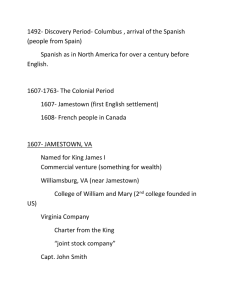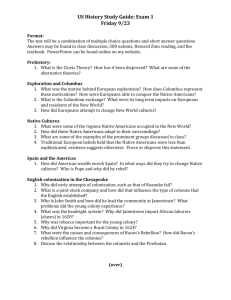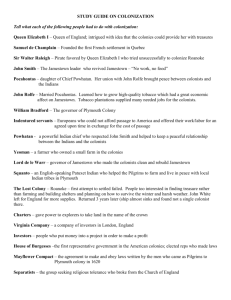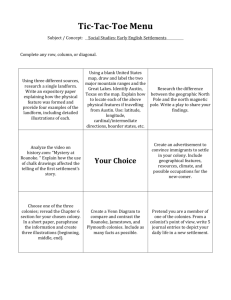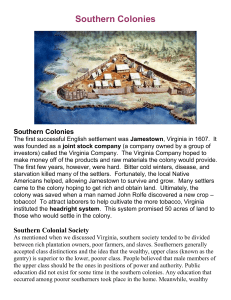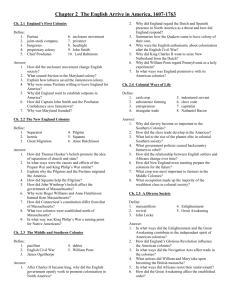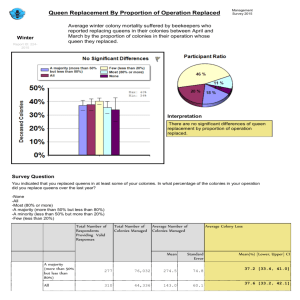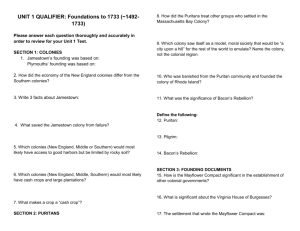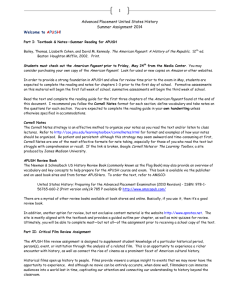Type your name here: ______ Chapter 2: The Planting of English
advertisement
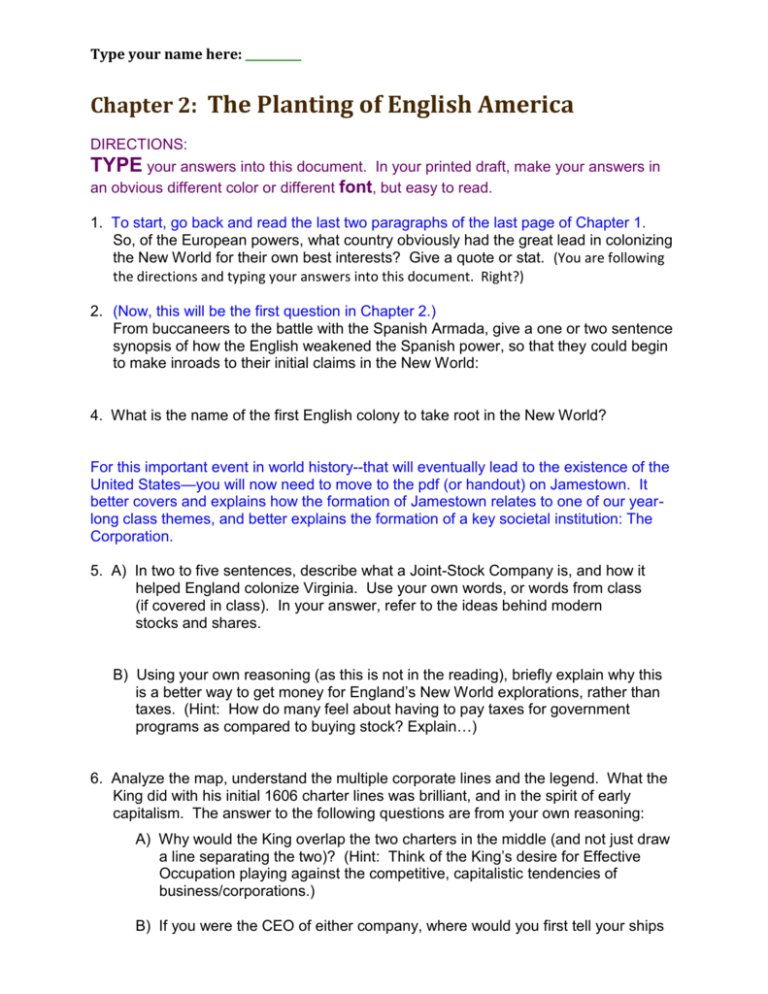
Type your name here: __________ Chapter 2: The Planting of English America DIRECTIONS: TYPE your answers into this document. In your printed draft, make your answers in an obvious different color or different font, but easy to read. 1. To start, go back and read the last two paragraphs of the last page of Chapter 1. So, of the European powers, what country obviously had the great lead in colonizing the New World for their own best interests? Give a quote or stat. (You are following the directions and typing your answers into this document. Right?) 2. (Now, this will be the first question in Chapter 2.) From buccaneers to the battle with the Spanish Armada, give a one or two sentence synopsis of how the English weakened the Spanish power, so that they could begin to make inroads to their initial claims in the New World: 4. What is the name of the first English colony to take root in the New World? For this important event in world history--that will eventually lead to the existence of the United States—you will now need to move to the pdf (or handout) on Jamestown. It better covers and explains how the formation of Jamestown relates to one of our yearlong class themes, and better explains the formation of a key societal institution: The Corporation. 5. A) In two to five sentences, describe what a Joint-Stock Company is, and how it helped England colonize Virginia. Use your own words, or words from class (if covered in class). In your answer, refer to the ideas behind modern stocks and shares. B) Using your own reasoning (as this is not in the reading), briefly explain why this is a better way to get money for England’s New World explorations, rather than taxes. (Hint: How do many feel about having to pay taxes for government programs as compared to buying stock? Explain…) 6. Analyze the map, understand the multiple corporate lines and the legend. What the King did with his initial 1606 charter lines was brilliant, and in the spirit of early capitalism. The answer to the following questions are from your own reasoning: A) Why would the King overlap the two charters in the middle (and not just draw a line separating the two)? (Hint: Think of the King’s desire for Effective Occupation playing against the competitive, capitalistic tendencies of business/corporations.) B) If you were the CEO of either company, where would you first tell your ships to target for settlement and development? –WHY? 6. A. List the three “orders form home.” B. What does this list say about what was of the greatest importance to those that funded this colony’s start? 7. List some problems faced by Jamestown colony between 1607 and 1624. 8. Why is John Smith important in this story of Jamestown? That is, what are one or two important things he did for the endeavor in Jamestown? 9. A. How did tobacco “save” the Jamestown colony? (After all, you can’t eat tobacco or make good shelter out of it…) B. So many Americans give John Smith credit for Tobacco and the colony’s profitability. It is simply a big goof by the American public. So, name the colonist who is truly the father of American profitability in tobacco? And now back to our normal class textbook. The class text does a better job of explaining the classic story of Powhatan, Pocahontas & John Smith. Go to page 29 in the text, and read the right column. 10. There are many books & movies that mangle the story of Pocahontas & John Smith, and which totally ignore who Pocahontas married in reality. So, in one sentence, set the record straight on this classic fable. 11. What were the factors leading to the downfall of the Powhatans? 12. Over the years and decades, more businessmen worked the tobacco trade, and entrepreneurs arrived in what was becoming an expanding, successful area with two more names: Virginia (as the entire coastline was originally named after the Queen, as shown on the map in the extra pdf), and the Chesapeake, and eventually the Chesapeake colonies (which—upon the formation of “The 13 Colonies”— become the cornerstone of The Southern Colonies). A) The early term “Chesapeake Colonies” gets its name from…what? (I don’t know that this is actually in the book. Hint: It is a landmark…) B) The first Chesapeake colony that will form into one of the 13 colonies and eventually a state is…? C) The second Chesapeake colony is Maryland, and in its formation, I see the name of its largest and famous city. So, in a sentence, write how is it we get Baltimore, Maryland? D) I guess, I better point this out one more time: The directions said to type your answers into this document. 13. Early social and socioeconomic formations: Slaves: Where in the English colonies did these come into our land’s history for the first time? Slaves: Regardless of your answer to slavery’s first foothold, where in England’s colonial holdings were they more crucial in this mid-1600’s time period? Indentured Servants: Define what these are, tell why they were needed. The first fight for religious tolerance was …where… in these colonies, and what was the result? On history’s timeline, Pilgrims and Puritans forming colonies further north would come next. However, the book wisely sticks with reviewing the formation of the rest of the Southern Colonies. So: 14. Here is a question whose answer will come in very handy in an upcoming computer lab simulation you will do: The economy of The West Indies was based on …what… crop? 15. Read all of Page 36 to answer these: Non-corporate English settlers were eventually squeezed out of The West Indies, and headed …where? And, the King soon granted a charter to some of his courtfavorites for this area. 16. A) The southern half of the area you named in the previous question was developed by people of …what kind of economic standing? …growing what crop? B) The owners of these crop efforts had to find labor that was talented and economically feasible for such large endeavors. Thus the labor was …? 17. A) The northern half of the area you named in question number 15 was populated by what economic and social class of English settlers? B) Their major cash crop? C) Labor used? 18. A) Why was Georgia founded? By whom? B) Why did Georgia grow “slowly?” Thus, maketh The Southern Colonies of The 13 Colonies. 19: So, sum up the general common characteristics of these “Southern Colonies.” Don’t make a list of items for each of these five colonies. Rather, take them as a whole; what are their common characteristics as a whole?
